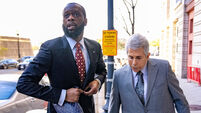The leaders of one tribe now represent the hopes of another
It’s the Shankill Road in Belfast, isn’t it?
Year in, year out, throughout the troubles in Northern Ireland, the Shankill Road was for Protestants, the Falls Road for Catholics. Shankill was loyalist; Falls republican.
The Shankill was always a difficult and sometimes frightening place to go if you were a southerner. In the earlier years of the troubles, the name Shankill Butchers was enough to strike fear into the heart. Savage murderers, who killed and tortured people at will simply because they were Catholic, they gave the entire area a name associated for years with terror.
I remember being there, nearly 14 years ago — though long after the Shankill Butchers, it was within a few days of the 1993 Shankill bomb massacre. You could still feel the tension and fear in the air. You could certainly feel that this was no place for a Dublin accent and a southern-registered car.
The Ulster Defence Association (UDA) was always strong on the Shankill Road. That’s why the Shankill massacre happened — apparently because the IRA got wind of a meeting that was supposed to take place in a room over a shop on the road. Most of the senior members of the UDA were supposed to be there, together with Johnny Adair of the Ulster Freedom Fighters.
But when two young IRA volunteers, Thomas Begley and Sean Kelly, carried their bomb into the shop, there was no meeting. There was only the owner of the shop, John Frizell, his daughter Sharon, and a lot of customers, because it was late on a Saturday afternoon.
Something went wrong with the bomb. Maybe they hadn’t set the timer right, or maybe whoever had sent those two young lads didn’t really care when the bomb went off.
But when it did, completely destroying the building, it took Thomas Begley’s life as well, and left Sean Kelly completely shattered.
It also destroyed the lives of many other people, nine of them killed and many more injured and maimed. John Frizell, his daughter and two children were among those blown to pieces.
The Shankill massacre wasn’t supposed to happen. All the talk at the time was of peace, of the IRA proposing a process that would bring an end to the killing. The Hume-Adams process it was called, and it was all over the newspapers. Hope was in the air, but Hume-Adams was almost destroyed when, a few days later, Gerry Adams carried the coffin of Thomas Begley to his final resting place.
Within days, a series of tit-for-tat killings began, culminating in the Greysteel massacre a week after Shankill. It was the UFF, Johnny Adair’s group, which carried out Greysteel, opening fire on a Halloween party in a bar with an AK-47 and killing eight people, six of whom were Catholics, in revenge for the nine Protestants killed on the Shankill Road.
Shankill bomber Sean Kelly recovered sufficiently from his injuries to be tried and convicted on nine counts of murder. Six years later, he was released from prison under the terms of the Good Friday Agreement. (So, as it happens, were the three killers convicted for the Greysteel massacre, one of whom was alleged to have shouted “trick or treat” when he opened fire on the Halloween party.) And Gerry Adams, the man who carried Thomas Begley’s coffin, is now the MP for the Shankill Road.
That might sound odd enough but as a result of the Assembly elections last week, the Shankill Road, the place synonymous with Protestantism, unionism, and loyalism, is to be represented in the newly-elected Northern Ireland Assembly by five Sinn Féin MLAs and by one SDLP MLA. Not a single unionist nor loyalist managed to get elected to represent a population that has more reason than most to hate and fear republicanism.
THERE are a lot of ironies in that, of course. Not the least of which is the fact that SDLP MLA Alex Attwood is a man who is detested by each of his Sinn Féin counterparts.
He has been a member of the Assembly since its inception, and he is both a staunch advocate of policing and a staunch critic of Sinn Féin’s attitude to policing.
As someone who has long advocated some of the things to which Sinn Féin has been implacably opposed, he has always been a thorn in its side.
It would dearly have loved to have unseated him from his place in the Assembly.
Sinn Féin almost pulled it off last week. When the boxes were opened in the six-seat constituency that is West Belfast, the constituency that has the Falls and Shankill roads running through it, Sinn Féin had pulled off an almost miraculous coup.
With a quota of 4,800, all five of the Sinn Féin candidates were within reach of it on the first count.
Gerry Adams had just over 6,000 votes, and each of the others had more than 4,200.
Attwood had a bare 3,000, and lay well behind Diane Dodds (wife of Nigel) of the DUP.
By the time Gerry Adams’ surplus had been distributed, it was clear that each of the other Sinn Féin candidates would be elected. But one other thing was clear. No transfers at all Dodds, while Attwood was picking up little parcels of votes from the Sinn Féin transfers.
Had there been any leakage at all to Dodds, Attwood would have struggled.
It was a triumph for the tribalism that always marks Northern Ireland politics.
As much as Sinn Féin dislikes Alex Attwood, for his courage and outspokenness, it dislikes DUP member Diane Dodds even more. In the end, Attwood survived.
Wouldn’t it have compounded the irony further if Sinn Féin had knocked Alex Attwood out?
During all the years when the Shankill Butchers reigned, and were matched by men capable of equal atrocity on the republican side, men and women like Alex Attwood stood for democracy and peace. They — all of them in the SDLP — worked hard to bring Sinn Féin and loyalism in from the cold, to try to make them part of the solution rather than part of the problem.
They did everything they could to try to break down tribal politics — and now their future is uncertain because they are no longer the first choice of their tribe.
In the ultimate irony, an accident of geography has ensured that the leaders of one tribe now represent the needs, aspirations, and hopes of the people of another.
Who would ever have predicted that the Shankill Road would be represented in the House of Commons by a Sinn Féin MP, and in the Northern Ireland Assembly by five Sinn Féin members?
But perhaps it’s the greatest challenge of all — and maybe there’s some justice in it. It was an IRA man who blew the Shankill Road apart, a few short years ago.















